In the dynamic world of financial markets, leverage stands out as a powerful yet double-edged strategy. At its core, leverage allows investors and traders to control larger positions with a relatively small amount of their own capital by borrowing additional funds. This borrowing magnifies the potential for both profits and losses, making it a critical concept for anyone involved in investing or trading. Whether you’re trading stocks, forex, commodities, or derivatives, understanding how leverage works—and the risks it carries—is essential. By exploring how leverage amplifies financial outcomes, this article will help you grasp its true impact and make more informed investment decisions.
What Is Leverage in Financial Markets?
Leverage in financial markets refers to the practice of using borrowed capital to increase the potential return of an investment. It enables investors to gain exposure to larger positions than their available funds would otherwise allow. For instance, with leverage, an investor with $10,000 can control a position worth $50,000, magnifying both potential gains and potential losses. This concept is commonly applied across various asset classes such as stocks, forex, commodities, and derivatives. Leverage acts much like a physical lever—providing more power with less effort—but in finance, this power comes with heightened risk. If the market moves in the investor’s favor, profits are multiplied; however, even a small adverse movement can quickly lead to significant losses. Therefore, while leverage opens the door to greater financial opportunities, it requires careful planning, sound risk management, and a deep understanding of market behavior.
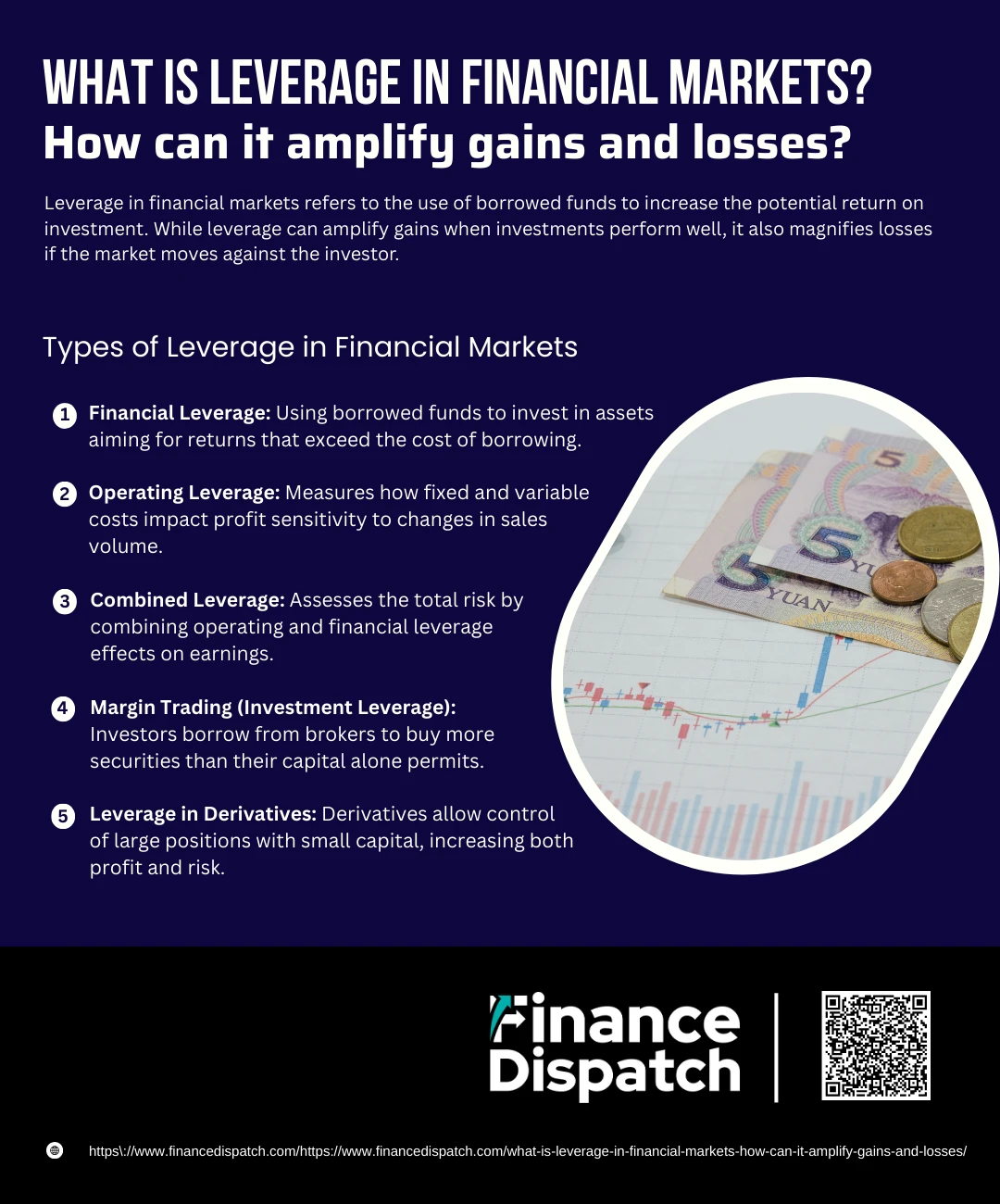 Types of Leverage in Financial Markets
Types of Leverage in Financial Markets
Leverage in financial markets is not a one-size-fits-all concept; it exists in various forms depending on how and where it is applied. Each type of leverage serves a different purpose, impacting investment returns, business operations, or both. Understanding these categories helps investors, traders, and businesses make strategic decisions tailored to their goals and risk tolerance. Below are the main types of leverage commonly used in financial markets:
1. Financial Leverage
This involves borrowing money to invest in assets or projects, with the aim of earning a return higher than the cost of borrowing. It’s commonly used by companies to fund expansion or by investors to magnify returns on investments.
2. Operating Leverage
Operating leverage measures how a company’s fixed and variable costs impact its profits. A business with high fixed costs and low variable costs can experience larger swings in profits with changes in sales volume, making it more sensitive to revenue fluctuations.
3. Combined Leverage
This is a blend of financial and operating leverage. It evaluates the total impact of both cost structure and borrowed capital on a company’s earnings, providing a comprehensive view of risk and return potential.
4. Margin Trading (Investment Leverage)
In financial markets, individual investors often use margin accounts to borrow funds from brokers to purchase more securities than their capital would otherwise permit. This increases potential returns but also exposes them to greater losses.
5. Leverage in Derivatives
Instruments like options, futures, and contracts for difference (CFDs) offer built-in leverage. They allow investors to control large positions with a small upfront investment, amplifying both profits and risks depending on market movements.
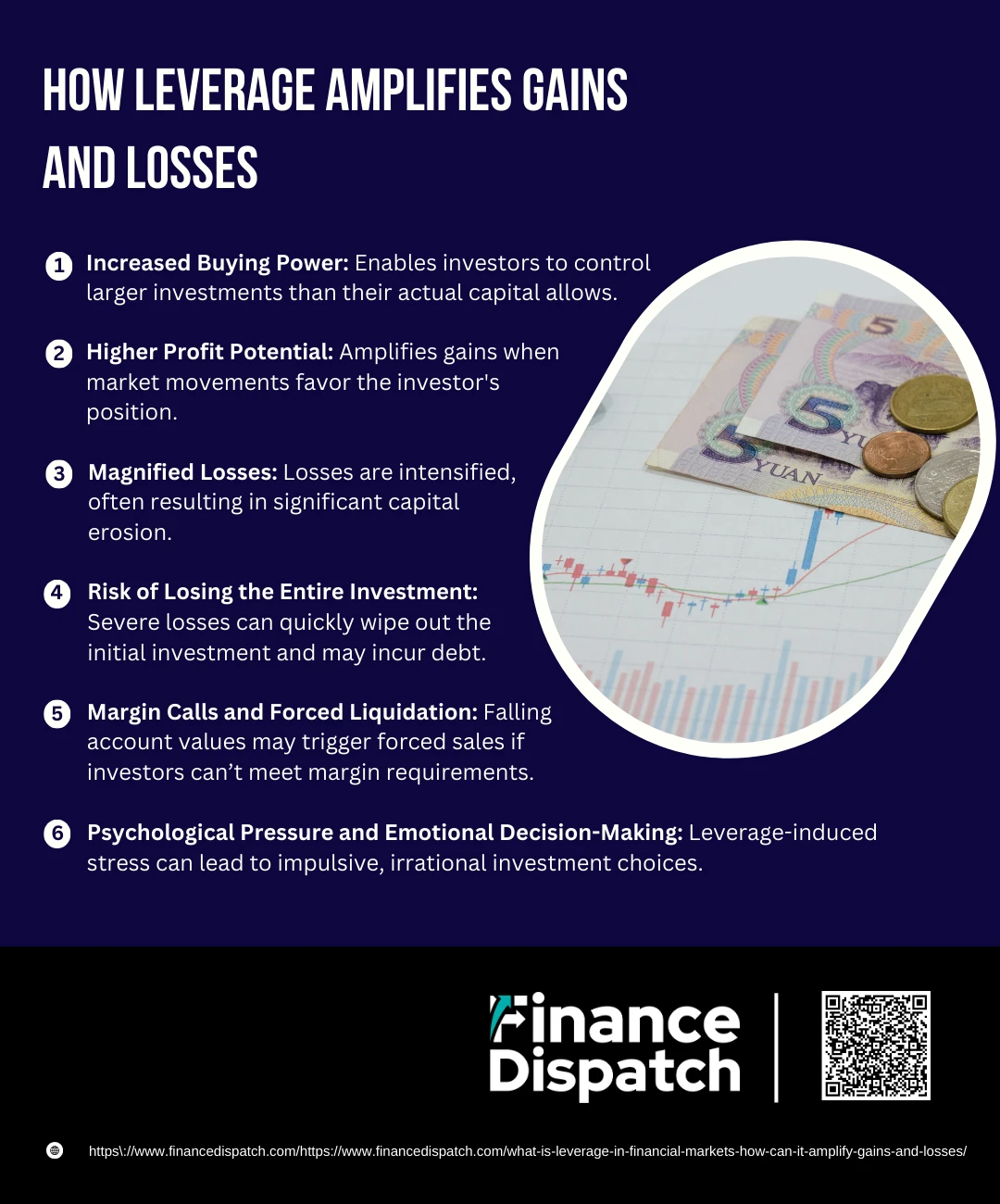 How Leverage Amplifies Gains and Losses
How Leverage Amplifies Gains and Losses
Leverage can be a game-changer in the financial markets, turning modest investments into potentially high returns. By borrowing funds to increase the size of an investment, leverage multiplies the outcomes—whether profitable or not. While it allows investors to access greater opportunities with less capital, it also introduces a higher degree of risk. The same force that enhances profits can just as easily magnify losses. Here’s how leverage works to amplify financial outcomes:
1. Increased Buying Power
With leverage, an investor can open a much larger position than their own capital would allow. For example, with 10:1 leverage, $10,000 of personal funds can be used to control a $100,000 investment. This expanded buying power enables greater market participation and access to higher-value assets.
2. Higher Profit Potential
When the market moves in the investor’s favor, the returns are calculated based on the total leveraged amount. Suppose a 5% price increase occurs on a $100,000 position—it would yield a $5,000 profit. Since the initial investment was only $10,000, that translates to a 50% return, far more than what would be earned without leverage.
3. Magnified Losses
The same mechanism that increases gains also multiplies losses. A 5% decline on the same $100,000 position results in a $5,000 loss—cutting the investor’s initial capital in half. Even small market fluctuations can therefore have a dramatic impact on leveraged positions.
4. Risk of Losing the Entire Investment
In highly leveraged trades, adverse price movements can wipe out the entire investment quickly. In extreme cases, investors may even owe more than their original capital if losses exceed the borrowed amount, especially in markets with high volatility or low liquidity.
5. Margin Calls and Forced Liquidation
Brokers may issue margin calls when the account value falls below a certain threshold, requiring the investor to deposit additional funds. If they fail to do so, the broker may forcibly close positions to limit further losses, often at unfavorable prices.
6. Psychological Pressure and Emotional Decision-Making
The heightened stakes introduced by leverage can lead to increased stress and emotional responses. Fear of loss or the temptation of quick gains may cause impulsive decisions, reducing the likelihood of following a disciplined investment strategy.
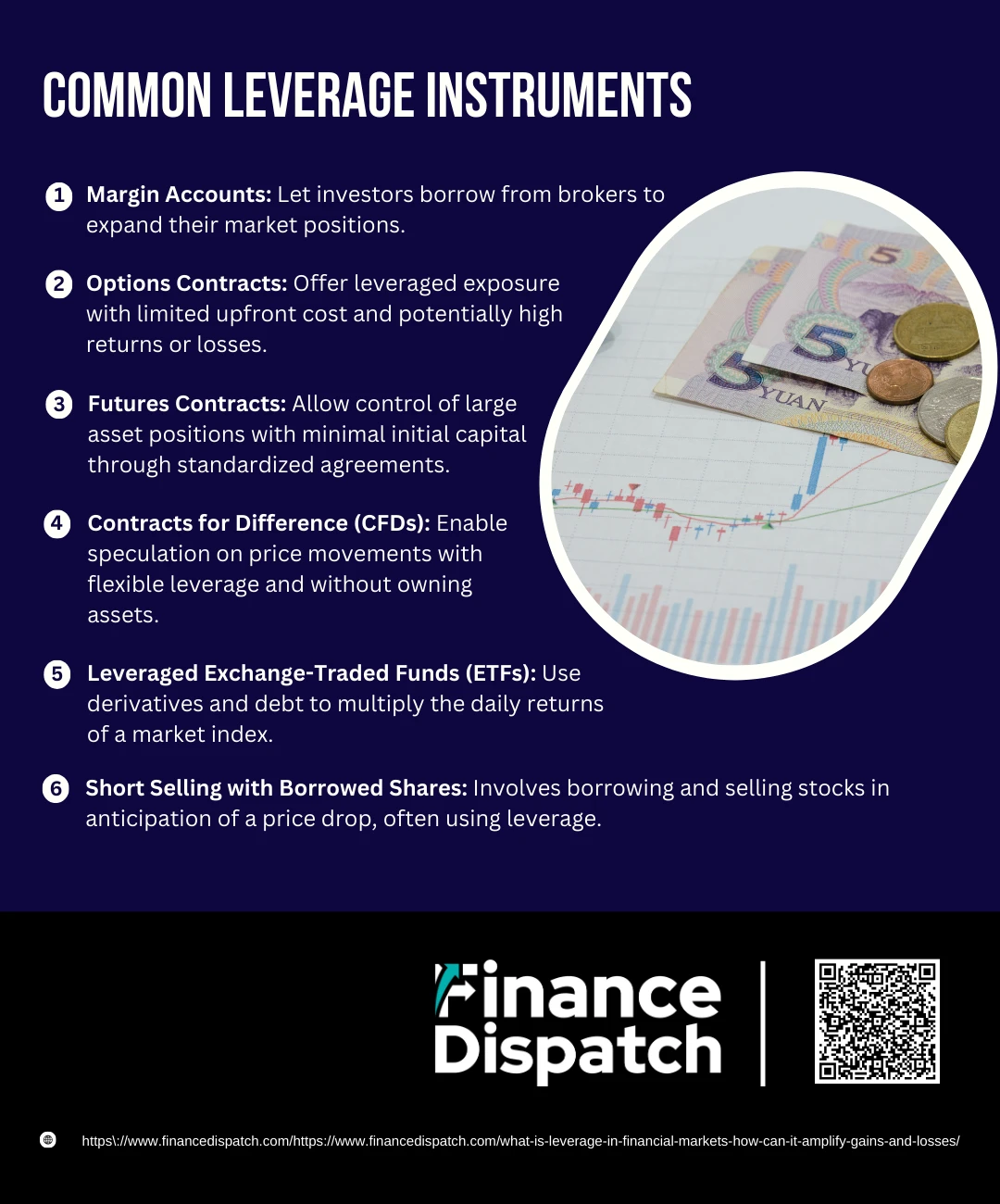 Common Leverage Instruments
Common Leverage Instruments
In financial markets, leverage can be accessed through various instruments designed to amplify investment exposure without requiring a large upfront capital outlay. These instruments enable traders and investors to control sizable positions, speculate on price movements, or hedge risks. While each has its unique structure and level of risk, they all function on the same principle—using borrowed capital to boost returns. However, with increased reward comes the potential for increased losses, making it essential to understand how these tools work before using them.
Here are some of the most common leverage instruments:
1. Margin Accounts
Offered by brokers, margin accounts allow investors to borrow money to purchase more securities than their available funds would otherwise permit. The securities themselves act as collateral. Margin trading is popular in stock markets and can magnify both profits and losses.
2. Options Contracts
Options give the holder the right—but not the obligation—to buy or sell an asset at a predetermined price. Because options require only a fraction of the asset’s value (called a premium), they offer built-in leverage and can lead to high returns—or total losses—depending on market movements.
3. Futures Contracts
Futures are agreements to buy or sell an asset at a future date for a set price. They require an initial margin (a small percentage of the contract’s total value), allowing traders to control large amounts of commodities, currencies, or indexes with limited capital. This makes them a high-leverage instrument.
4. Contracts for Difference (CFDs)
CFDs are derivative products that let traders speculate on the price movement of financial instruments without owning the underlying asset. They offer flexible leverage and are widely used in forex and equity markets. Small market changes can have significant impacts when trading CFDs.
5. Leveraged Exchange-Traded Funds (ETFs)
These are specialized ETFs that use financial derivatives and debt to amplify the returns of an underlying index, often aiming to deliver two or three times the daily movement of the index. While they can offer rapid gains, they also carry the risk of magnified losses, especially in volatile markets.
6. Short Selling with Borrowed Shares
In short selling, an investor borrows shares and sells them with the intention of buying them back at a lower price. This strategy often involves margin and can be considered a leveraged play, as losses can be unlimited if the stock price rises instead of falling.
Leverage vs. Margin
Leverage and margin are closely related concepts in the financial world, often used interchangeably but with distinct meanings and applications. Leverage refers to the broader strategy of using borrowed funds to increase the potential return on an investment. Margin, on the other hand, is the specific amount of money an investor must deposit as collateral to access leverage. Essentially, margin is the gateway through which leverage is applied. Understanding the differences between the two helps investors make more informed decisions and manage risk more effectively.
Here’s a clear comparison between leverage and margin:
| Aspect | Leverage | Margin |
| Definition | The use of borrowed funds to increase investment exposure | The amount of capital required to open and maintain a leveraged position |
| Function | Amplifies potential gains and losses | Acts as a security deposit for using leverage |
| Expression | Expressed as a ratio (e.g., 5:1 or 10x) | Expressed as a percentage (e.g., 20% margin means 5x leverage) |
| Purpose | To control larger positions with less capital | To fulfill broker requirements for borrowing |
| Risk Implication | Increases both reward potential and exposure to losses | Determines how quickly you might face a margin call |
| Market Use | Applied in forex, derivatives, real estate, stock trading | Used in margin accounts, options trading, and futures |
| Example | Controlling $100,000 with $10,000 at 10:1 leverage | Putting up $10,000 to open a $50,000 trade with 20% margin |
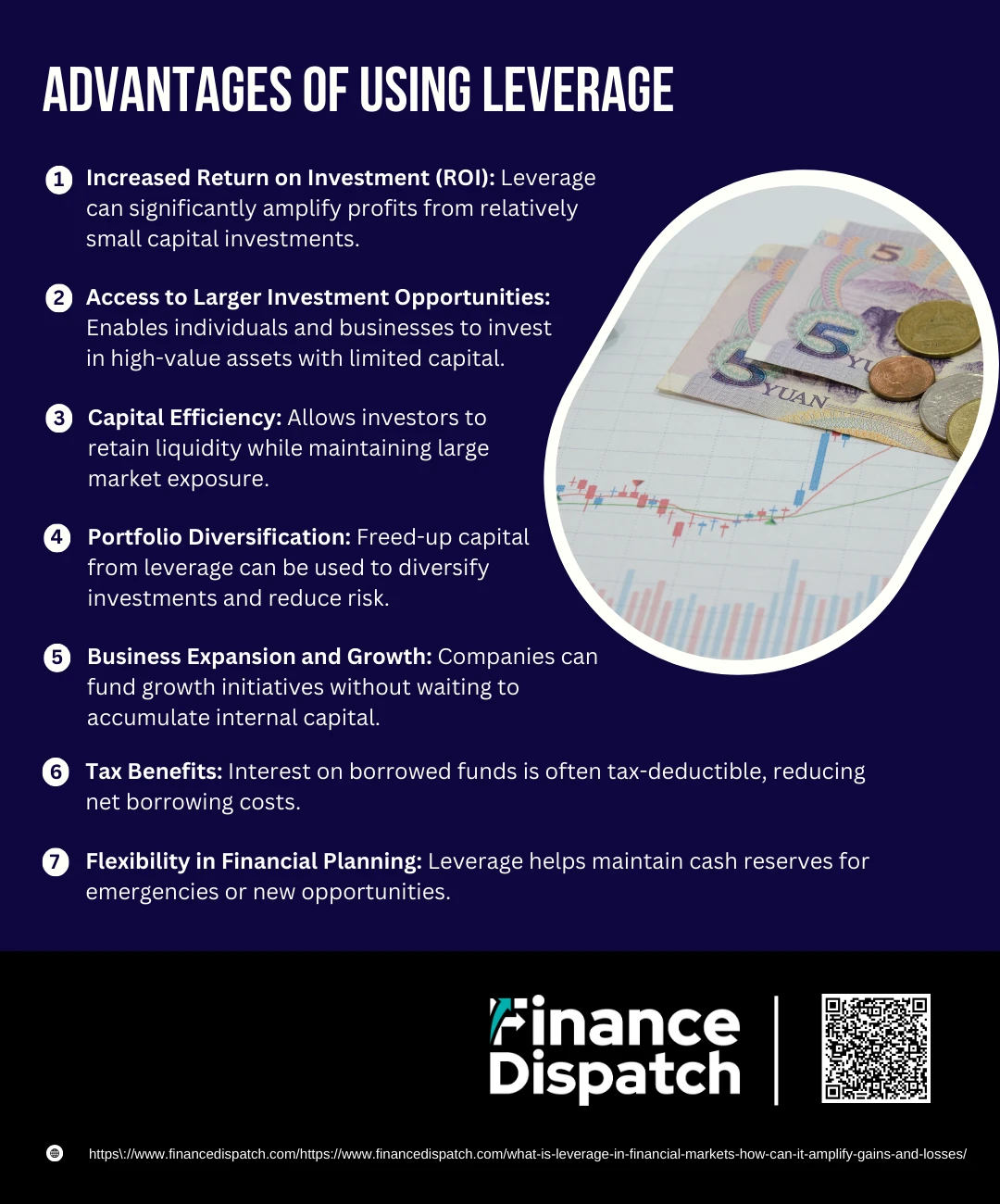 Advantages of Using Leverage
Advantages of Using Leverage
Leverage is a financial strategy that empowers individuals and businesses to stretch their capital further by using borrowed funds to increase their investment size or operational capacity. Rather than relying solely on personal or internal funds, leverage provides a way to pursue larger opportunities, diversify portfolios, and enhance profitability. While it carries risk, when used responsibly, leverage can offer substantial benefits that would be difficult to achieve through unleveraged strategies alone. Below are the detailed advantages of using leverage in financial markets and business operations:
1. Increased Return on Investment (ROI)
One of the most appealing aspects of leverage is its potential to significantly boost returns. Since the investor is using borrowed funds to increase the size of the position, even a small positive movement in the market can lead to substantial gains on the initial capital. For example, a 10% gain on a $100,000 leveraged investment—funded with only $20,000 of personal capital—results in a 50% return, far higher than if the investor had used their own capital alone.
2. Access to Larger Investment Opportunities
Leverage opens doors to high-value investments that would otherwise be unaffordable. For example, real estate investors can buy properties worth millions with only a fraction of the capital, thanks to mortgages. Similarly, traders can use margin to invest in larger positions in stocks, commodities, or currencies, increasing their exposure and profit potential.
3. Capital Efficiency
By using leverage, investors can commit less of their own money while maintaining full market exposure. This efficient use of capital allows them to retain cash for other investments, emergency funds, or personal financial goals, rather than locking it all into a single trade or project.
4. Portfolio Diversification
With capital freed up through leveraging, investors are able to spread their funds across a broader range of assets. This diversification reduces overall portfolio risk and ensures that a downturn in one investment doesn’t completely derail the entire strategy.
5. Business Expansion and Growth
In the corporate world, leverage allows companies to invest in growth opportunities such as launching new products, entering new markets, or acquiring other businesses. Instead of waiting to accumulate capital, they can accelerate growth timelines and compete more effectively, using borrowed funds to fuel innovation and expansion.
6. Tax Benefits
For businesses, interest paid on borrowed funds is often tax-deductible. This reduces the overall tax burden and improves the net return on investments. By factoring in these savings, the cost of borrowing may be lower than the return generated from the investment, making leverage even more attractive.
7. Flexibility in Financial Planning
Leverage provides flexibility by allowing companies and investors to keep cash reserves intact for other purposes. Rather than exhausting their own capital, they can use leverage strategically while maintaining liquidity, improving their ability to respond to unexpected opportunities or market downturns.
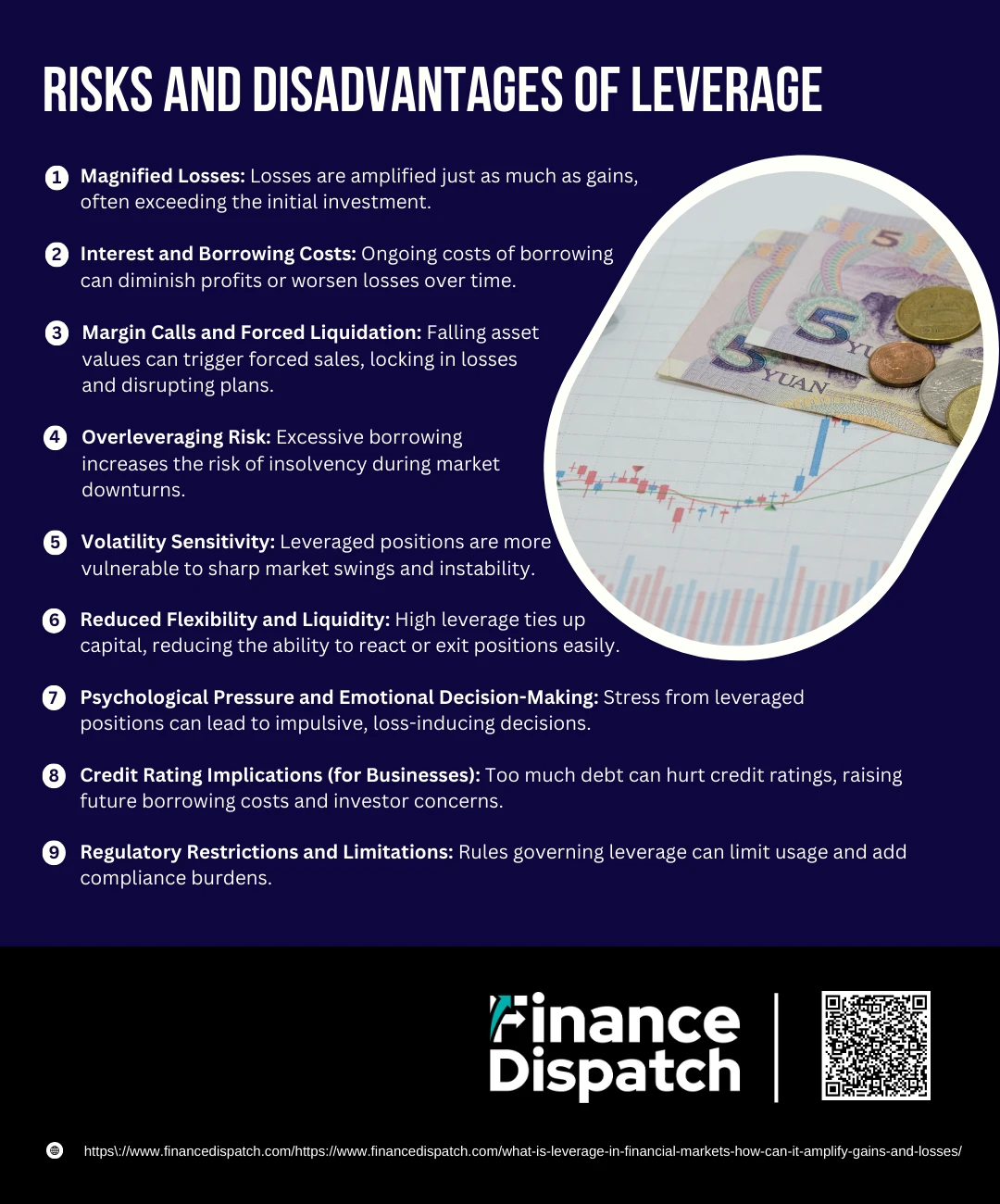 Risks and Disadvantages of Leverage
Risks and Disadvantages of Leverage
Leverage, while offering the potential to multiply returns, also significantly increases exposure to financial risk. The very mechanism that allows investors to amplify profits can turn against them just as quickly, resulting in accelerated losses. Leverage requires careful monitoring, sound judgment, and strict discipline. Without proper management, it can quickly lead to financial instability, debt overload, or even insolvency. Both individuals and businesses must understand these drawbacks in detail before incorporating leverage into their financial strategies.
Here are the key risks and disadvantages of leverage:
1. Magnified Losses
The most fundamental risk of leverage is that it amplifies not only gains but also losses. A small downward movement in the market can lead to disproportionately large losses when leverage is involved. For example, a 10% drop in a leveraged investment with 5:1 leverage could result in a 50% loss on the investor’s actual capital. In some cases, losses can even exceed the original investment, putting personal or business assets at risk.
2. Interest and Borrowing Costs
Leverage isn’t free—borrowed funds come with interest and fees that must be repaid regardless of investment performance. These costs can erode profits over time, particularly in low-return environments. For businesses, these expenses reduce operating margins, and for investors, they create ongoing financial pressure even during stagnant market periods.
3. Margin Calls and Forced Liquidation
When the value of a leveraged position falls below a certain level, brokers may issue a margin call, demanding the investor to deposit additional funds or collateral. If the investor fails to meet the margin call, the broker may sell off the investor’s assets—often at a loss—to recover the loaned funds. This forced liquidation can lock in losses and further destabilize financial plans.
4. Overleveraging Risk
Overleveraging occurs when too much debt is taken relative to equity or cash flow. It increases vulnerability to even minor market shifts. In severe cases, overleveraging can lead to bankruptcy or corporate collapse, as seen in numerous financial crises where firms took on more debt than they could manage during downturns.
5. Volatility Sensitivity
Leveraged positions react more sharply to price fluctuations. A volatile market that might cause minor concern for an unleveraged investor can devastate someone with high leverage. This increased sensitivity makes leveraged investments riskier during uncertain or turbulent market conditions.
6. Reduced Flexibility and Liquidity
High leverage limits flexibility. Investors and companies may find themselves “locked in” to positions, unable to exit without incurring major losses or facing penalties. It also reduces liquidity, as a significant portion of capital may be tied up to maintain margin requirements or service debt.
7. Psychological Pressure and Emotional Decision-Making
The stress of managing large, leveraged positions can lead to fear-driven decisions, such as exiting positions too early or doubling down on losing trades in hopes of recovery. These emotional responses often undermine long-term strategies and can result in greater financial losses.
8. Credit Rating Implications (for Businesses)
For corporations, excessive reliance on debt can negatively affect credit ratings. A lower credit rating means higher interest rates on future borrowings, reduced access to capital markets, and a loss of investor confidence—ultimately impairing growth prospects.
9. Regulatory Restrictions and Limitations
Regulatory bodies often impose strict limits on the amount of leverage that can be used, especially in banking and financial sectors. Violating these rules can result in fines, trading restrictions, or legal action. Staying compliant adds another layer of complexity and responsibility when managing leverage.
Real-World Examples of Leverage
Leverage is not just a theoretical concept—it’s widely used by individuals, businesses, and even governments to expand their financial reach. Whether it’s purchasing property, growing a company, or managing complex investment portfolios, leverage has played a central role in many notable financial successes and failures. These real-world examples illustrate how leverage can be a powerful tool when managed wisely and a dangerous trap when misused.
Here are some prominent examples of leverage in action:
1. Real Estate Investment: A property investor uses a mortgage to buy a $500,000 home by putting down only $100,000 of personal capital. If the property appreciates to $550,000, the investor earns a 50% return on their actual investment—thanks to financial leverage through borrowing.
2. Warren Buffett and Berkshire Hathaway: Buffett famously used “insurance float” as leverage. By collecting premiums upfront and delaying payouts, he invested that money into profitable ventures—amplifying Berkshire Hathaway’s growth over decades without incurring traditional debt.
3. Corporate Acquisitions: Microsoft used leverage in the form of corporate debt to finance its $26 billion acquisition of LinkedIn. Rather than using cash reserves, it utilized cheap borrowing to preserve capital while expanding strategically.
4. Leveraged Hedge Funds: Many hedge funds borrow money to increase the size of their positions. For instance, if a hedge fund borrows $4 for every $1 of capital, a 5% gain on the total investment results in a 25% return on equity—but a 5% loss would also mean a 25% loss.
5. The 2008 Financial Crisis: Financial institutions used excessive leverage through mortgage-backed securities. When housing prices fell, highly leveraged positions collapsed, leading to massive bankruptcies, government bailouts, and a global recession.
6. Small Business Expansion: A local restaurant takes a business loan to open a second location. By leveraging debt instead of waiting to accumulate cash, the owner accelerates growth and increases income—assuming the new branch performs well.
Risk Management Strategies of Leverage
Leverage can supercharge profits, but it can also magnify losses just as quickly. To use leverage effectively, investors and businesses must adopt disciplined risk management strategies. Without proper safeguards, even a small market downturn can trigger margin calls, forced liquidations, or significant financial losses. Smart leverage users plan ahead, monitor their positions closely, and follow well-defined rules to minimize downside risks. Below are key strategies that can help manage the inherent risks of leverage:
1. Set Clear Leverage Limits: Establish a maximum leverage ratio based on your risk tolerance, capital base, and investment goals. Avoid using all available leverage, as overextension increases vulnerability to market swings.
2. Use Stop-Loss Orders: Implement stop-loss orders to automatically exit positions if prices move beyond a predetermined threshold. This limits losses and removes emotional decision-making during market volatility.
3. Diversify Your Portfolio: Don’t put all your leveraged capital into one asset or sector. Spread risk across various asset classes to minimize the impact of any single poor-performing investment.
4. Regularly Monitor Market Conditions: Stay informed about market trends, economic indicators, and global events that could affect your leveraged positions. Reacting early to changes can help reduce potential losses.
5. Maintain a Capital Buffer: Always keep extra cash or liquid assets on hand to meet margin calls or cover unexpected losses without being forced to liquidate assets under pressure.
6. Apply the Right Leverage Ratio: Use leverage conservatively, especially in volatile markets. Lower ratios (like 2:1 or 3:1) may offer sufficient exposure while keeping risk manageable.
7. Conduct Stress Testing: Simulate worst-case scenarios to understand how your portfolio would perform under extreme conditions. This helps identify vulnerabilities and prepare contingency plans.
8. Use Hedging Techniques: Instruments like options or inverse ETFs can serve as insurance for leveraged positions, providing downside protection during unfavorable market moves.
9. Avoid Emotional Decision-Making: Stick to your strategy and don’t let fear or greed dictate your actions. Emotional responses often lead to overleveraging or panic selling.
10. Seek Professional Advice: Especially for high-stakes or complex leverage strategies, consulting with a financial advisor or risk manager can help tailor a plan that aligns with your goals and risk appetite.
Conclusion
Leverage is a powerful financial mechanism that, when used wisely, can unlock greater investment opportunities, amplify returns, and support business growth. However, its strength lies in its dual nature—it magnifies both gains and losses. As such, leveraging should never be approached lightly. Understanding the types of leverage, the instruments involved, and the risks they carry is essential for making informed decisions. With proper risk management strategies, such as setting clear limits, maintaining capital buffers, and diversifying investments, leverage can serve as a strategic advantage rather than a financial hazard. Ultimately, success with leverage depends not just on market conditions, but on discipline, knowledge, and a well-planned approach.



